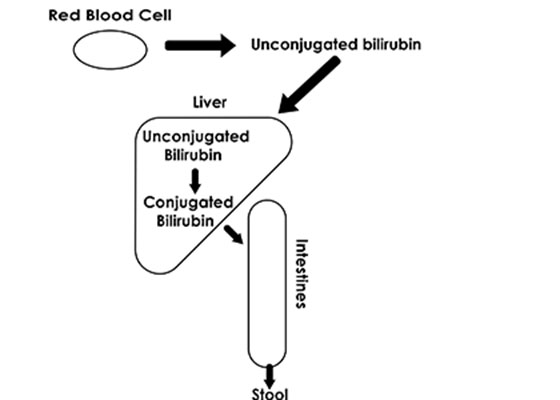This post is also available in:
![]() Español (Spanish)
Español (Spanish) ![]() Français (French)
Français (French)
What is Gilbert’s syndrome?
Gilbert’s syndrome is a genetic condition in which the liver is slow to clear bilirubin from the body. Bilirubin is a substance that comes from the natural breakdown of red blood cells. Normally, bilirubin is removed from the body by the liver, which releases bilirubin into the intestines. In Gilbert’s syndrome, bilirubin breakdown is slow. This can lead to build-up of bilirubin in the liver and mildly elevated levels of bilirubin in the blood.

What causes Gilbert’s syndrome?
Gilbert’s syndrome is inherited, or genetic, and occurs when there is a change (mutation) in our genes. The gene affected is called UGT1A1, and it makes an enzyme that helps clear bilirubin from the body.
Normally, bilirubin enters the liver from the blood and is changed into a form (called conjugated bilirubin) that can be released from the liver into bile ducts (ducts that drain the liver). Conjugated bilirubin then enters the intestines, where it becomes part of the stool and is removed from the body.
Bilirubin is one of the compounds that makes stool appear brown or green. In Gilbert’s syndrome, the enzyme that changes the bilirubin (uridyl glucuronyltransferase) is less active. This less active enzyme processes bilirubin more slowly, causing it to build-up in the body.
What are the signs of Gilbert’s syndrome?
Some people who have Gilbert’s syndrome do not have any symptoms. Others may show signs as a baby or during puberty. The most common sign is jaundice, or yellowing of the skin and/or eyes. The yellow color is caused by high levels of bilirubin in the blood. This is not harmful.
It is less common for people with Gilbert’s syndrome to complain of feeling tired (fatigue) or weak and to have nausea or abdominal pain.
Episodes of jaundice and other symptoms come and go. They may occur when someone is sick with a viral illness, exercises too much, becomes dehydrated, skips meals or fasts, or is stressed.
Gilbert’s syndrome is often diagnosed after routine blood testing. A physician may be testing to evaluate another condition, such as abdominal pain, and notice slightly elevated bilirubin levels. If total bilirubin levels are high and conjugated bilirubin levels are low, Gilbert’s syndrome is a possible diagnosis.
What causes you to have Gilbert’s syndrome?
Gilbert’s syndrome runs in families who have a change in the UGT1A1 gene. There is no increased risk based on diet, medications, or lifestyle.
How is Gilbert’s syndrome diagnosed?
A diagnosis of Gilbert’s syndrome is usually suspected while checking blood work for other conditions or if a patient has mild jaundice. Your doctor may do some more testing to rule out other problems with the liver or a blood-related condition that causes breakdown of red blood cells, which can explain elevated bilirubin levels.
In Gilbert’s syndrome, there is mild elevation of total bilirubin and low levels of conjugated bilirubin. Other liver tests and blood tests are normal. Genetic testing can also be done to check for a mutation, although this is generally not done because the condition has no negative health implications.
What is the treatment of Gilbert’s syndrome?
Gilbert’s syndrome is a benign condition and requires no specific treatment.
Written by:
Vania Kasper, MD & Mohit Kehar, MD
Edited by: Athos Bousvaros, MD
Date: May 2021
This post is also available in:
![]() Español (Spanish)
Español (Spanish) ![]() Français (French)
Français (French)






